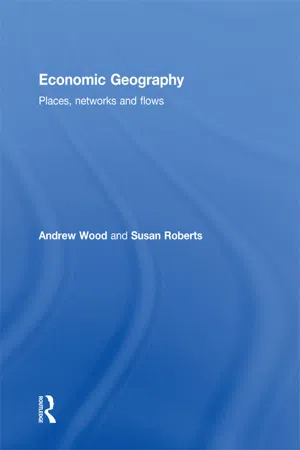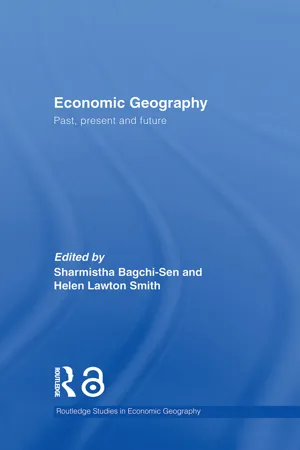Economic Activity
Economic activity refers to the production, distribution, and consumption of goods and services within a specific geographic area. It encompasses all the actions and transactions that contribute to the overall economic well-being of a region, including agriculture, manufacturing, trade, and services. Understanding economic activity is crucial for analyzing the development and prosperity of a place.
4 Key excerpts on "Economic Activity"
- eBook - ePub
Economic Geography
Places, Networks and Flows
- Andrew Wood, Susan Roberts(Authors)
- 2012(Publication Date)
- Routledge(Publisher)
...These concerns, in turn, are related to a third issue which involve the very meaning of ‘economic’ activity and ‘economic’ life. Once again traditional approaches have a very narrow and restrictive definition of what counts as ‘economic.’ Furthermore, the economic sphere is positioned as separate from social life. As we suggest in Chapter 8 recent work in economic geography has served to unbound the ‘economic,’ encouraging a more holistic and catholic understanding of what counts as Economic Activity and thus what counts as economic geography. CONCLUSIONS What we have examined in Chapter 3 builds on the pioneering work of the German location theorists introduced in Chapter 2. In extending their work traditional economic geographers have sought to retain the emphasis on formal, abstract models and general principles that help to account for and explain the geographies of economic life. This work continues to have significant value and the recent attention directed to Paul Krugman's work has served to highlight its contemporary salience. Yet the penchant for abstract models also reflects a deeper set of ideas and values that have been subject to more recent critical attention. In part this reflects recognition of the complexity of economic life but, perhaps more importantly, it also calls into question a number of the basic assumptions on which traditional economic geography has been based. In Part II of the book we begin to examine the various ways in which work in economic geography has evolved into a more plural and diverse field. While we should not dismiss the significance and power of traditional forms of analysis we generally see the more recent developments in Parts II and III as important steps in overcoming some of the shortfalls associated with traditional work. EXERCISE 3.1 Using news sources, search for recent examples of major investments in a local or regional economy of interest...
- eBook - ePub
- Roberta Capello(Author)
- 2015(Publication Date)
- Routledge(Publisher)
...Introduction 1 Economics and space Economic Activity arises, grows and develops in space. Firms, and economic actors in general, choose their locations in the same way as they choose their production factors and their technology. Productive resources are distributed unevenly in space: they are frequently concentrated in specific places (regions or cities) while they are entirely or partly non-existent in others. Quantitative and qualitative imbalances in the geographical distribution of resources and economic activities generate different factor remunerations, different levels of wealth and well-being, and different degrees of control over local development. The problem of factor allocation – which economists have conventionally treated as being the efficient allocation of the factors among various types of production – is more complex than this, in fact; and it is so because the spatial dimension is of crucial importance. Space influences the workings of an economic system. It is a source of economic advantages (or disadvantages) such as high (or low) endowments of production factors. It also generates geographical advantages, like the easy (or difficult) accessibility of an area and a high (or low) endowment of raw materials. Space is also the source of advantages springing from the cumulative nature of productive processes in space: in particular, spatial proximity generates economies that reduce production costs (e.g. the transportation costs of activities operating in closely concentrated filières) and, in more modern terms, transaction costs (e.g. the costs of market transactions due to information gathering). These considerations highlight the need to supersede the purely allocative approach typical of a static interpretation of economic phenomena with a dynamic, indeed evolutionary, approach which ties allocative decisions to processes of development...
- eBook - ePub
Economic Geography
Past, Present and Future
- Sharmistha Bagchi-Sen, Helen Lawton-Smith, Sharmistha Bagchi-Sen, Helen Lawton-Smith(Authors)
- 2006(Publication Date)
- Routledge(Publisher)
...Significant contributions came from non-geographers such as the role of service industries in economic development, uneven distribution of producer services, connections between society and the rise of the service sector among others. During the 1980s and early 1990s, economic geographers highlighted the fact that producer services are the key to understanding the basic function of services in urban or regional economies. After the mid 1990s, economic geographers examined the role of producer services in global networks and the characteristics of particular types of services. Daniels reminds us that: Research on the relationship between developments in information and communications technology (ICT) and the supply, demand, quality and spatial distribution services is far from exhausted, not least as offshoring and outsourcing of both routine and higher-order service tasks presents economic challenges to some developed economies and opportunities for newly emerging economies. David Angel offers how several topics attracted enquiries in environmental economic geography: an examination of the evolution in patterns of environmental regulation of firms and industries, higher level of scrutiny of firms’ activities around the world, and climate change and environmental challenges. Currently, the approaches of study of environmental economic geography include the greening of industry and the political ecology of industrial change. For the greening of industry approach, researches are firm-centred and mainly fall into three categories: consequences of changes in global production networks for economic development, technological innovations and environmental performance, and flows of capital, technology, and information and the dynamic of economic globalization...
- eBook - ePub
Great Minds in Entrepreneurship Research
Contributions, Critiques, and Conversations
- Vishal K. Gupta(Author)
- 2020(Publication Date)
- Palgrave Macmillan(Publisher)
...The latter is the focus of the Marshallian ‘industrial district’. 6 The clusters in Jutland (Denmark) have received some attention in the industrial districts literature (Schmitz & Musyck, 2016), but others question their existence and performance (Engelstoft, Jensen-Butler, Smith, & Winther, 2006). 7 There are other examples too, such as the export-oriented garment industry cluster in Bangladesh (Sonobe, 2016). 8 The database was compiled, and quality-checked by, a private firm, The Futures Group, for the United States Small Business Administration. It was based on new product announcement sections in over 100 technology, engineering, and trade journals across every conceivable industry, and categorized innovations at the four-digit SIC level. 9 For Clark, Feldman, Gertler, and Wójcik (2018 : 1), geography is about the “why and so what of where,” so that economic geography relates to the “where, why, and so what questions are focused on understanding economy.” The word ‘economy’ is used in a broad sense to refer to the “totality of processes through which individuals, households, and societies make a living and sustain themselves.” From their perspective, economic geography is limited not just to the formal economy, but also includes “informal economy, both ‘grey’, such as household production, and ‘black’, such as illegal drug trade.” 10 Despite the popular appeal of this idea, such interdisciplinary collaboration has been rare in entrepreneurship research (Zahra, 2005). It is also notable that while researchers in entrepreneurship did—and still do—come from other academic fields, a majority of entrepreneurship researchers now consider the entrepreneurship division as their primary disciplinary home in the Academy of Management (Fried, 2003)....



